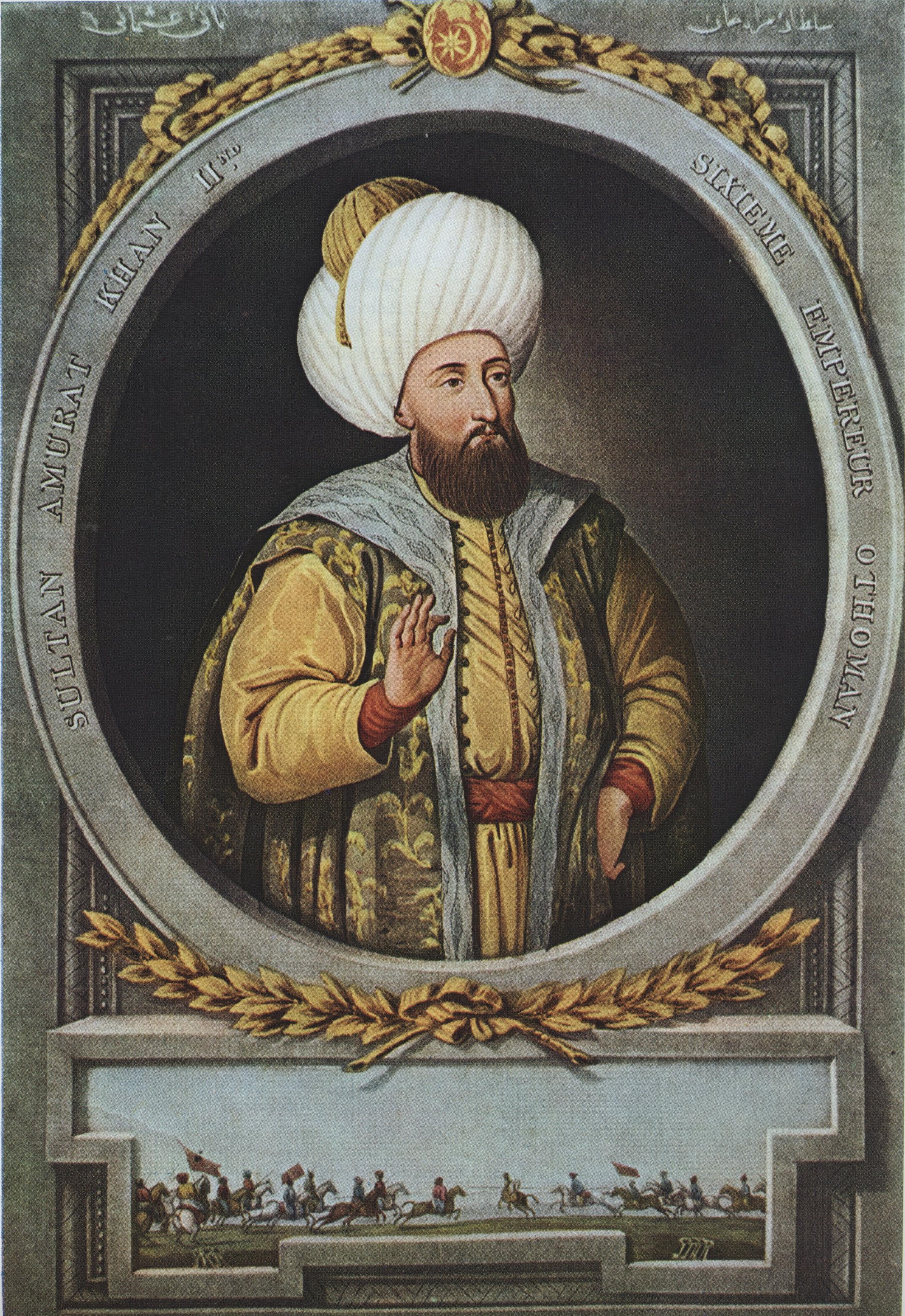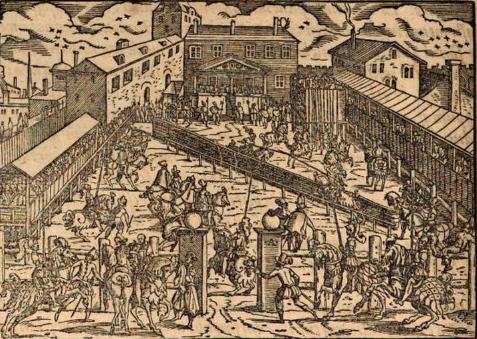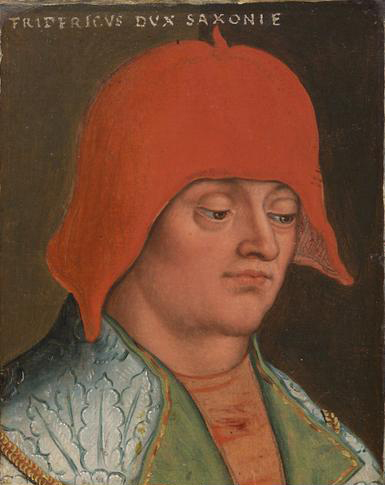|
1451
Year 1451 ( MCDLI) was a common year starting on Friday of the Julian calendar. Events January–June * January 7 – Pope Nicholas V issues a Papal Bull to establish The University of Glasgow; classes are initially held in Glasgow Cathedral. * January 27 – The Saxon Brother War between Frederick II, Elector of Saxony and William III, Landgrave of Thuringia is ended as two brothers sign a peace treaty at Naumburg. * February 3 – Murad II, Sultan of the Ottoman Empire, dies and is succeeded (on February 18) by his son, Mehmed II. * February 14 – Louis XI of France marries Charlotte of Savoy. * March 26 – The Treaty of Gaeta is signed at the Italian city of Gaeta between the Kingdom of Albania (represented by Nikollë de Berguçi and Stefan, Bishop of Krujë on behalf of Skanderbeg, and the Kingdom of Naples (by King Alfonso. In return for protection of Albania from the Ottoman Empire, Albania agrees to be a vassal of Naples. * April 11 &n ... [...More Info...] [...Related Items...] OR: [Wikipedia] [Google] [Baidu] |
Mehmed II
Mehmed II (; , ; 30 March 14323 May 1481), commonly known as Mehmed the Conqueror (; ), was twice the sultan of the Ottoman Empire from August 1444 to September 1446 and then later from February 1451 to May 1481. In Mehmed II's first reign, he defeated the crusade led by John Hunyadi after the Hungarian incursions into his country broke the conditions of the truce per the Peace of Szeged, Treaties of Edirne and Szeged. When Mehmed II ascended the throne again in 1451, he strengthened the Ottoman Navy and made preparations to attack Constantinople. At the age of 21, he Fall of Constantinople, conquered Constantinople and brought an end to the Byzantine Empire. After the conquest, Mehmed claimed the title Caesar (title), caesar of Roman Empire, Rome (), based on the fact that Constantinople had been the seat and capital of the surviving Byzantine Empire, Eastern Roman Empire since its consecration in 330 AD by Constantine the Great, Emperor Constantine I. The claim was soon reco ... [...More Info...] [...Related Items...] OR: [Wikipedia] [Google] [Baidu] |
Skanderbeg
Gjergj Kastrioti (17 January 1468), commonly known as Skanderbeg, was an Albanians, Albanian Albanian nobility, feudal lord and military commander who led Skanderbeg's rebellion, a rebellion against the Ottoman Empire in what is today Albania, North Macedonia, Greece, Kosovo, Montenegro, and Serbia. A member of the noble House of Kastrioti, Kastrioti family, Skanderbeg was sent as a hostage to the Ottoman court. He graduated from the Enderun School and entered the service of the Ottoman sultan Murad II () for the next twenty years. His rise through the ranks culminated in his appointment as of the Sanjak of Dibra in 1440. During the Battle of Nish (1443), Battle of Nish in 1443, he deserted the Ottomans and Liberation of Kruja (1443), became the ruler of Krujë and nearby areas extending from Petrelë to Modrič, Struga, Modrič. In March 1444, he established the League of Lezhë, with support from Albanian nobility, local noblemen, and unified the Albanian principalities. In ... [...More Info...] [...Related Items...] OR: [Wikipedia] [Google] [Baidu] |
Murad II
Murad II (, ; June 1404 – 3 February 1451) was twice the sultan of the Ottoman Empire, from 1421 to 1444 and from 1446 to 1451. Early life Murad was born in June 1404 to Mehmed I, while the identity of his mother is disputed according to various accounts. According to 15th century historian Şükrullah, Murad's mother was a concubine. Hüseyin Hüsâmeddin Yasar, an early 20th century historian, wrote in his work ''Amasya Tarihi'' that his mother was Şahzade Hatun, daughter of Divitdar Ahmed Pasha. According to historians İsmail Hami Danişmend, and Heath W. Lowry, his mother was Emine Hatun, a Dulkadirids, Dulkadirid princess. He spent his early childhood in Amasya. In 1410, Murad came along with his father to the Ottoman Empire, Ottoman capital, Edirne. After his father ascended to the Ottoman throne, he made Murad governor of the Amasya Sanjak. Murad remained at Amasya until the death of Mehmed I in 1421. He was solemnly recognized as sultan of the Ottoman Sultanate at ... [...More Info...] [...Related Items...] OR: [Wikipedia] [Google] [Baidu] |
Treaty Of Gaeta
The Treaty of Gaeta was a political treaty signed in Gaeta on March 26, 1451, between Alfonso V for the Kingdom of Naples and Stefan, Bishop of Krujë, and Nikollë de Berguçi, ambassadors of Skanderbeg. In the treaty Skanderbeg recognized himself a vassal of the Kingdom of Naples, and in return he would have the Kingdom's protection from the Ottoman Empire. Alfonso V believed that he would be able to resurrect the politics of his Angevine predecessors and to use Albania as a foothold to further expand his realm into the Balkans. Terms of the Treaty The treaty was requested by Skanderbeg in order to ensure protection from the Ottoman Empire. Although the party on the treaty was Alfonso V himself, the treaty was signed by his main notary, Arnaldo Fonolleda. The ambassadors of Skanderbeg were respectively two bishops: Stefan was an orthodox bishop and de Berguçi was a Catholic Dominican bishop. According to the treaty, if the Albanians were to need the Kingdom of Naples's hel ... [...More Info...] [...Related Items...] OR: [Wikipedia] [Google] [Baidu] |
University Of Glasgow
The University of Glasgow (abbreviated as ''Glas.'' in Post-nominal letters, post-nominals; ) is a Public university, public research university in Glasgow, Scotland. Founded by papal bull in , it is the List of oldest universities in continuous operation, fourth-oldest university in the English-speaking world and one of Scotland's four Ancient universities of Scotland, ancient universities. Along with the universities of University of St Andrews, St Andrews, University of Aberdeen, Aberdeen, and University of Edinburgh, Edinburgh, the university was part of the Scottish Enlightenment during the 18th century. Glasgow is the List of universities in Scotland, second largest university in Scotland by total enrolment and -largest in the United Kingdom. In common with universities of the pre-modern era, Glasgow originally educated students primarily from wealthy backgrounds; however, it became a pioneer in British higher education in the 19th century by also providing for the needs o ... [...More Info...] [...Related Items...] OR: [Wikipedia] [Google] [Baidu] |
Celje
Celje (, , ) is the List of cities and towns in Slovenia, third-largest city in Slovenia. It is a regional center of the traditional Slovenian region of Styria (Slovenia), Styria and the administrative seat of the City Municipality of Celje. The town is located below Celje Castle, Upper Celje Castle at the confluence of the Savinja, Hudinja (river), Hudinja, Ložnica, and Voglajna rivers in the lower Savinja Valley, and at the crossing of the roads connecting Ljubljana, Maribor, Velenje, and the Central Sava Valley. Name Celje was known as ''Celeia'' during the Roman Empire, Roman period. Early attestations of the name during or following Slavic settlement include ''Cylia'' in 452, ''ecclesiae Celejanae'' in 579, ''Zellia'' in 824, ''in Cilia'' in 1310, ''Cilli'' in 1311, and ''Celee'' in 1575. The proto-Slovene name ''*Ceľe'' or ''*Celьje'', from which modern Slovene ''Celje'' developed, was borrowed from Vulgar Latin ''Celeae''. The name is of pre-Roman origin and its furthe ... [...More Info...] [...Related Items...] OR: [Wikipedia] [Google] [Baidu] |
Charlotte Of Savoy
Charlotte of Savoy (16 November 1441 – 1 December 1483) was Queen of France as the second spouse of Louis XI. She served as regent during the king's absence in 1465, and was a member of the royal regency council during her son's minority in 1483. Life She was a daughter of Louis, Duke of SavoyJoachim W. Stieber, ''Pope Eugenius IV, the Council of Basel and the Secular and Ecclesiastical Authorities in the Empire'', (E.J. Brill, 1978), 254. and Anne of Cyprus.Sharon L. Jansen, ''Anne of France: Lessons For My Daughter'', ed. Jane Chance, (Boydell & Brewer, 2004), 2-3 She was one of 19 children, 14 of whom survived infancy. Marriage On 11 March 1443, when Charlotte was just over a year old, she was betrothed to Frederick of Saxony (28 August 1439- 23 December 1451), eldest son of Frederick II, Elector of Saxony. The betrothal did not lead to a marriage, however, was annulled for reasons unknown. The younger Frederick died at the age of 12. On 14 February 1451, 10 months befo ... [...More Info...] [...Related Items...] OR: [Wikipedia] [Google] [Baidu] |
Louis XI Of France
Louis XI (3 July 1423 – 30 August 1483), called "Louis the Prudent" (), was King of France from 1461 to 1483. He succeeded his father, Charles VII. Louis entered into open rebellion against his father in a short-lived revolt known as the Praguerie in 1440. The king forgave his rebellious vassals, including Louis, to whom he entrusted the management of the Dauphiné, then a province in southeastern France. Louis's ceaseless intrigues, however, led his father to banish him from court. From the Dauphiné, Louis led his own political establishment and married Charlotte of Savoy, daughter of Louis, Duke of Savoy, against the will of his father. Charles VII sent an army to compel his son to his will, but Louis fled to Burgundy, where he was hosted by Philip the Good, the Duke of Burgundy, Charles's greatest enemy. When Charles VII died in 1461, Louis left the Burgundian court to take possession of his kingdom. His taste for intrigue and his intense diplomatic activity earne ... [...More Info...] [...Related Items...] OR: [Wikipedia] [Google] [Baidu] |
Ottoman Dynasty
The Ottoman dynasty () consisted of the members of the imperial House of Osman (), also known as the Ottomans (). According to Ottoman tradition, the family originated from the Kayı tribe branch of the Oghuz Turks, under the leadership of Osman I in northwestern Anatolia in the district of Bilecik, Söğüt. The Ottoman dynasty, named after Osman I, ruled the Ottoman Empire from 1299 to 1922. During much of the Empire's history, the sultan was the absolute regent, head of state, and head of government, though much of the power often shifted to other officials such as the Grand Vizier of the Ottoman Empire, Grand Vizier. During the First Constitutional Era, First (1876–78) and Second Constitutional Eras (1908–20) of the late Empire, a shift to a constitutional monarchy was enacted, with the Grand Vizier taking on a prime ministerial role as head of government and heading an elected General Assembly of the Ottoman Empire, General Assembly. The imperial family was deposed ... [...More Info...] [...Related Items...] OR: [Wikipedia] [Google] [Baidu] |
February 3
Events Pre-1600 * 1047 – Drogo of Hauteville is elected as count of the Apulian Normans during the Norman conquest of Southern Italy. * 1112 – Ramon Berenguer III, Count of Barcelona, and Douce I, Countess of Provence, marry, uniting the fortunes of those two states. * 1451 – Sultan Mehmed II inherits the throne of the Ottoman Empire. * 1488 – Bartolomeu Dias of Portugal lands in Mossel Bay after rounding the Cape of Good Hope, becoming the first known European to travel so far south. * 1509 – The Portuguese navy defeats a joint fleet of the Ottoman Empire, the Republic of Venice, the Sultan of Gujarat, the Mamlûk Burji Sultanate of Egypt, the Zamorin of Calicut, and the Republic of Ragusa at the Battle of Diu in Diu, India. * 1583 – Battle of São Vicente takes place off Portuguese Brazil where three English warships led by navigator Edward Fenton fight off three Spanish galleons sinking one in the process. 1601–1900 ... [...More Info...] [...Related Items...] OR: [Wikipedia] [Google] [Baidu] |
Ottoman Empire
The Ottoman Empire (), also called the Turkish Empire, was an empire, imperial realm that controlled much of Southeast Europe, West Asia, and North Africa from the 14th to early 20th centuries; it also controlled parts of southeastern Central Europe, between the early 16th and early 18th centuries. The empire emerged from a Anatolian beyliks, ''beylik'', or principality, founded in northwestern Anatolia in by the Turkoman (ethnonym), Turkoman tribal leader Osman I. His successors Ottoman wars in Europe, conquered much of Anatolia and expanded into the Balkans by the mid-14th century, transforming their petty kingdom into a transcontinental empire. The Ottomans ended the Byzantine Empire with the Fall of Constantinople, conquest of Constantinople in 1453 by Mehmed II. With its capital at History of Istanbul#Ottoman Empire, Constantinople (modern-day Istanbul) and control over a significant portion of the Mediterranean Basin, the Ottoman Empire was at the centre of interacti ... [...More Info...] [...Related Items...] OR: [Wikipedia] [Google] [Baidu] |
Frederick II, Elector Of Saxony
Frederick II, The Gentle (''Friedrich, der Sanftmütige''; Frederick the Gentle; 22 August 1412 – 7 September 1464) was Elector of Saxony (1428–1464) and was Landgrave of Thuringia (1440–1445). Biography Frederick was born in Leipzig, the eldest of the seven children of Frederick I, Elector of Saxony, and Catherine of Brunswick-Lüneburg, Catherine of Brunswick and Lunenburg. After the death of his father in 1428 he took over the government together with his younger brothers William III, Duke of Saxony, William III, Henry and Sigismund. In 1433 the Wettin (dynasty), Wettins finally concluded peace with the Hussites and in 1438 Frederick led Saxon forces to victory in the Battle of Sellnitz. That same year it was considered the first federal state parliament of Saxony. The parliament received the right to find together in case of innovations in fiscal matters also without summoning by the ruler. Also in 1438 it was decided that Frederick, and not his rival Bernard IV, duk ... [...More Info...] [...Related Items...] OR: [Wikipedia] [Google] [Baidu] |









